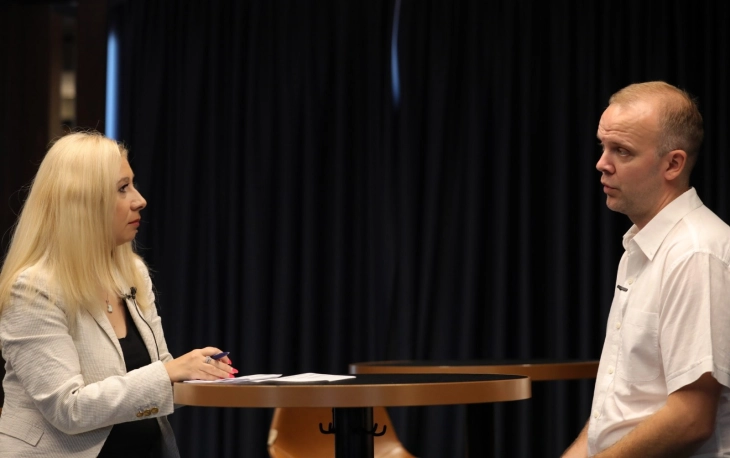Kivimae: The sooner you become digitized, the easier it'll be to discover corruption and fraud
- In Estonia, considered a digital technology leader in Europe and the world, there are at the moment 80 tools based on artificial intelligence technology that can do what people can. Having started digitizing in the early 1990s, Estonia is now a digital wonder. In North Macedonia, on the other hand, experts agree that the country has a lot of talented people that develop AI-related technologies, however it is a devastating fact that young people are leaving the country, which is why it is necessary for the institutions to make efforts to motivate them to stay here and develop software for the country.

Skopje, 24 July 2024 (MIA) – In Estonia, considered a digital technology leader in Europe and the world, there are at the moment 80 tools based on artificial intelligence technology that can do what people can. Having started digitizing in the early 1990s, Estonia is now a digital wonder. In North Macedonia, on the other hand, experts agree that the country has a lot of talented people that develop AI-related technologies, however it is a devastating fact that young people are leaving the country, which is why it is necessary for the institutions to make efforts to motivate them to stay here and develop software for the country.
Minister for Digital Transformation Stefan Andonovski speaking last week at the National Convention on the European Union in the Republic of North Macedonia (NCEU-MK) said that the potential of talented young people enrolling in technical faculties should be fully used in the development of the ICT sector in the country.
According to him, discussions about artificial intelligence, tools for improving transparency, for discovering potential corruption are not possible if over 90 percent of the institutions still have data on paper, which is being shared in the traditional way without them being connected in a digitized environment… Even though there is a system, he said, the institutions don’t use it.
Andonovski announced that Smart Macedonia, a comprehensive government initiative, includes the development of a national ICT strategy, to be considered an umbrella of all government activities that will be in line with the Europe’s Digital Decade: 2030 Targets, the European Commission’s initiative for digital transformation.

Juri Kivimae, Estonian expert and data analyst at the Estonian Tax and Customs Board, said the sooner the country digitizes, the easier it will be to discover cases of corruption and fraud.
Kivimae, who was also part of the NCEU-MK session last week, speaking to MIA said that Estonia started digitizing as soon as gaining independence from the Soviet Union.
“I would argue that it was not so quick, already in the 80s we were one of the tech hubs of the Soviet Union and that was already a start. Then, in the 90s we invested heavily in IT and communications infrastructure, especially on education and that was a good start. So, it has been almost over 30-40 years in the making. We have taken steps, we have made mistakes, but we have gained the public trust with the use of digital services and it’s just going from there,” Kimivae said.
Estonia, he added, in 2002 introduced identification cards with digital signature, which opened access to a growing number of online services. The country in 2012 introduced mobile IDs followed by smart IDs.
Estonia today, Kivimae said, offers a wide range of public services available online, for example to check health records, register a company, and register a vehicle and to check property and cadaster-related information amongst other things.
In Estonia, he explained, the artificial intelligence (AI) tools are called kratts, according to the mythical creature in Estonian folklore. Over 80 kratts (tools) are used at the moment in the country, based on AI technology.
Kivimae said that one example of AI-based tools is automatic transcription in real time for public television stations. “Another good example is the use of satellite terrain footage and also emergency services have a transcription of the calls they are receiving. There is also AI chat in public services,” he told MIA.

Asked to what extent digitization can prevent corruption, Kivimae said the sooner the country is digitized the easier it will be to discover corruption.
“Working for the tax and customs board, my answer is subjective, I would say the digitalization of taxes and custom systems has aided in corruption, the movement of paper-based and cash-based to a paperless and cashless, card-based society and transactions, that has definitely made it easier to discover corruption, to discover fraud. But also the convenience of use of these digital services has definitely helped,” he said.
Even though the country and all other Western Balkans counties are lagging behind in the digitization process, Kivimae said it still represents an excellent opportunity to share experience and practices with Estonia and other European countries.
“While the Balkans has been lagging behind, I would say that this is a great opportunity to learn from Estonia and from other European countries and from countries over the world that have gotten very far with their digitalization projects, with their public sector digitalization, and the more time goes by the more of good-use cases or how to do it, how to move forward, are available for Macedonia and for anybody who wants to modernize their public sector,” he stated.
The use of digital services has definitely improved the lives of the citizens of Estonia, he noted.
“We went from having almost no digital services to having card-based authentication, phone-based authentication, and at the same time all services that previously were done through offices and authorities, can now be done over one single website that is trusted by the public, that you can sign in, authenticated, said Kivimae.

Regarding the implementation of AI in the public sector, the Estonian expert said there are different methods to develop models – from a company having a good reputation for the development of AI models, to a certain scientists. However, he added, it isn’t cheap to change the AI model and it will have no use unless quality data is inserted.
Kivimae said that the EU cooperates a lot as regards the use of AI, such as the Fiscalis program, of which North Macedonia is already a member.
Neda Dimova Prokikj
Photo: Frosina Naskovikj
Video: Srgjan Krstikj and Andrej Brankovikj











